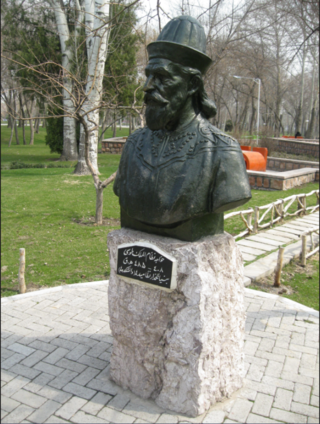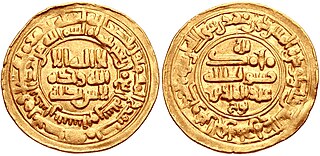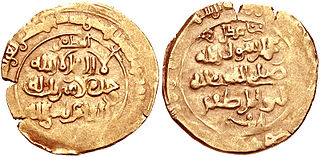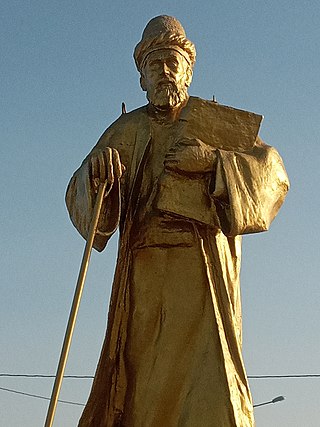Related Research Articles

Malik-Shah I, was the third sultan of the Seljuk Empire from 1072 to 1092, under whom the sultanate reached its zenith of power and influence.

The Tahirid dynasty was an Arabized Persian Sunni Muslim dynasty of dehqan origin that ruled as governors of Khorasan from 821 to 873 as well as serving as military and security commanders in Abbasid Baghdad until 891. The dynasty was founded by Tahir ibn Husayn, a leading general in the service of the Abbasid caliph al-Ma'mun. For his support of al-Ma'mun in the Fourth Fitna, he was granted the governance of Khorasan.

Abu Ali Hasan ibn Ali Tusi, better known by his honorific title of Nizam al-Mulk was a Persian scholar, jurist, political philosopher and Vizier of the Seljuk Empire. Rising from a lowly position within the empire, he effectively became the de facto ruler of the empire for 20 years after the assassination of Sultan Alp Arslan in 1072, serving as the archetypal "good vizier". Viewed by many historians as "the most important statesman in Islamic history", the policies implemented by Nizam al-Mulk would go on to remain as the basic foundation for administrative state structures in the Muslim world up until the 20th century.

Abu Shuja Ghiyath al-Dunya wa'l-Din Muhammad ibn Malik-Shah, better known as Muhammad I Tapar, was the sultan of the Seljuk Empire from 1105 to 1118. He was a son of Malik-Shah I and Taj al-Din Khatun Safariya. In Turkish, Tapar means "he who obtains, finds".

Abd al-Malik I was amir of the Samanid Empire from 954 to 961. He was the son and successor of Nuh I. His reign was marked by internal strife, with the Turkic slave-soldiers increasing in power. He died after falling from his horse during a game of polo at Bukhara. He was succeeded by his brother Mansur I, who was put on the throne by a faction of ghulams led by the Turkic slave-commander, Fa'iq Khassa.

Rukn al-Din Abu'l-Muzaffar Berkyaruq ibn Malikshah, better known as Berkyaruq (برکیارق), was the fifth sultan of the Seljuk Empire from 1094 to 1105.

Abu'l-Hasan Ali ibn Julugh Farrukhi Sistani, better known as Farrukhi Sistani was one of the most prominent Persian court poets in the history of Persian literature. Initially serving a dehqan in Sistan and the Muhtajids in Chaghaniyan, Farrukhi entered the service of the Ghaznavids in 1017, where he became the panegyrist of its rulers, Mahmud and Mas'ud I, as well as numerous viziers and princes.

The Seljuk dynasty, or Seljukids, Seljuqs, also known as Seljuk Turks, Seljuk Turkomans or the Saljuqids, was an Oghuz Turkic, Sunni Muslim dynasty that gradually became Persianate and contributed to the Turco-Persian tradition in the medieval Middle East and Central Asia. The Seljuks established the Seljuk Empire (1037–1194), the Sultanate of Kermân (1041–1186) and the Sultanate of Rum (1074–1308), which at their heights stretched from Iran to Anatolia and were the prime targets of the First Crusade.

Abdallah ibn Tahir was a military leader and the Tahirid governor of Khurasan from 828 until his death. He is perhaps the most famous of the Tahirids. His career spanned twenty-five years under three caliphs, al-Ma'mun, al-Mu'tasim, and al-Wathiq. Militarily, he is known for defeating the powerful rebels Nasr ibn Shabath in the Jazira and Ubaydallah ibn al-Sari in Egypt.
Shabankara was an Iranian tribe. They claimed descent from the mythical Iranian king Manuchehr who had been deported to eastern Fars from Isfahan by the Buyid Shahanshah 'Adud al-Dawla. The dynasty's capital was Ij (Ig) and was divided in six districts: Zarkān, Iṣṭabānān, Burk-Tārum-K̲h̲ayra, Nayriz, Kurm-Rūnīz-Lār, and Darabjird. The tribe had the following subdivisions: Ismāʿīlī, the Rāmānī, the Karzuwī, the Masʿūdī and the S̲h̲akānī who were all herders and warriors.
The Seljuk Empire, or the GreatSeljuk Empire, was a high medieval empire, culturally Turco-Persian, founded and ruled by the Qïnïq branch of Oghuz Turks. It spanned a total area of 3.9 million square kilometres from Anatolia and the Levant in the west to the Hindu Kush in the east, and from Central Asia in the north to the Persian Gulf in the south.
Abu 'l-Fadl Muhammad ibn Abi Abdallah al-Husayn ibn Muhammad al-Katib, commonly known after his father as Ibn al-'Amid was a Persian statesman who served as the vizier of the Buyid ruler Rukn al-Dawla for thirty years, from 940 until his death in 970. His son, Abu'l-Fath Ali ibn Muhammad, also called Ibn al-'Amid, succeeded him in his office.

Ibrahim of Ghazna was sultan of the Ghaznavid empire from April 1059 until his death in 1099. Having been imprisoned at the fortress of Barghund, he was one of the Ghaznavid princes that escaped the usurper Toghrul's massacre in 1052. After his brother Farrukh-Zad took power, Ibrahim was sent to the fortress of Nay, the same fortress where the poet Masud Sa'd Salman would later be imprisoned for ten years.
Ḍiyaʾ al-Mulk Aḥmad ibn Niẓām al-Mulk, was a Persian vizier of the Seljuq Empire and then the Abbasid Caliphate. He was the son of Nizam al-Mulk, one of the most famous viziers of the Seljuq Empire.

Amid al-Mulk Abu Nasr al-Kunduri, commonly known as al-Kunduri, was a Persian bureaucrat, who served as the vizier of the first Seljuk Sultan Tughril and his nephew Alp Arslan.
The Mikalid family, also known as the Mikalis, was a prominent Iranian aristocratic family of Khorasan from the 9th century to the 11th century. They were descended from the pre-Islamic nobility of Samarkand.
Anushirvan ibn Khalid ibn Muhammad Kashani, also known as Abu Nasr Sharaf al-Din, was a Persian statesman and historian, who served as the vizier of the Seljuq Empire and the Abbasid Caliphate.

The Kerman Seljuk Sultanate was a Persianate Sunni Muslim state, established in the parts of Kerman and Makran which had been conquered from the Buyid dynasty by the Seljuk Empire which was established by the Seljuk dynasty, which was of Oghuz Turkic origin. The Founder of this dynasty, Emadeddin Kara Arslan Ahmad Qavurt who succeeded the ruler of this dynasty after the surrender of the ruler of Buyyids, Abu Kalijar Marzuban. For first time in this period, an independent state was formed in Kerman; eventually, after 150 years, with the invasion of the Ghuzz leader Malik Dinar, the Kerman Seljuk Sultanate fell.
Mu'ayyid al-Mulk was a Persian bureaucrat, who served as the vizier of the Seljuk sultan Berkyaruq from 1094 to 1095, and later vizier of the Seljuk prince and contender Muhammad I Tapar from 1099 to 1101. He was the most energetic and gifted of the sons of Nizam al-Mulk, with whom he neared in capability.
Fakhr al-Mulk was a Persian bureaucrat, who served as the vizier of the Seljuk sultan Berkyaruq from 1095 to 1099, and later vizier of the Sejluk prince and ruler of Khurasan, Ahmad Sanjar, from 1101 to 1106. He was the eldest son of the prominent Seljuk vizier Nizam al-Mulk.
References
- ↑ A. TAFAŻŻOLĪ: DEHQĀN. In: Encyclopædia Iranica. online ed., 2010: "... In the early Islamic centuries many important political figures of eastern Persia were dehqāns (e.g., the Samanid amir Aḥmad b. Sahl b. Hāšem, q.v.) or descendants of dehqān families (e.g., the Saljuq grand vizier Neẓām-al-Molk, q.v.; Gardīzī, p. 151; Ebn Fondoq, pp. 73, 78) [...] The profound attachment of the dehqāns to the culture of ancient Iran also lent to the word dehqān the sense of “Persian,” especially “Persian of noble blood,” in contrast to Arabs, Turks, and Romans in particular ..."
- ↑ H. Bowen, C.E. Bosworth: Niẓām al-Mulk. In: Encyclopaedia of Islam.
- ↑ Gibb, H. A. R. (1960–1985). The Encyclopedia of Islam, vol. 8. Leiden: Brill. p. 70.